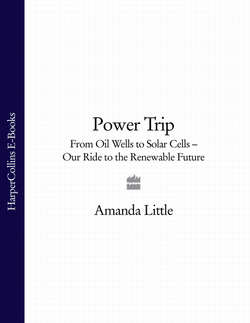Читать книгу Power Trip: From Oil Wells to Solar Cells – Our Ride to the Renewable Future - Amanda Little - Страница 27
STORMY DESERT
ОглавлениеTrouble bubbled up again in the Middle East in the 1980s as combative neighbors Iran and Iraq fought out a long-running territorial skirmish in a costly and inconclusive war. At the war’s end, the regime of Saddam Hussein was heavily in debt and the country’s petroleum infrastructure was in disrepair. Saddam, who had assumed the presidency in 1979, saw an opportunity to erase his debt by seizing the thriving oil fields of neighboring Kuwait. Holding nearly 10 percent of global oil reserves, tiny Kuwait was on a per capita basis one of the wealthiest nations in the world. On August 2, 1990, Saddam Hussein’s forces invaded and rapidly succeeded in occupying Kuwait.
The United States responded with what was soon dubbed Operation Desert Storm—the first Gulf War. In January 1991, the George H. W. Bush administration declared its intention of removing Iraq from Kuwait—in part to protect the Gulf oil fields. When Dick Cheney, who was than the secretary of defense, described the motivation for war, he cited the Carter doctrine: “that basic fundmental doctrine I think is still in effect today.” Cheney listed among the United States’ “major concerns…the very real possibility that should Saddam Hussein…be allowed to keep Kuwait, that he would be in a position to directly control over 20 percent of the world’s proven oil reserves.” Cheney envisioned a snowball effect in which Saddam would eventually command all the oil in the Middle East:
Altogether, the Persian Gulf region contains over 70 percent of the world’s proven oil reserves. And the prospects that a man like Saddam Hussein, with his enormous military machine, would be allowed to sit astride that resource without any countervailing force, would be allowed to control the flow of oil to the world’s economy, and…use the enormous wealth that would be generated for nefarious purposes is a prospect that I think most of the world’s civilized nations find abhorrent.
It was a remarkable comment: U.S. leaders had justified war with explicit reference to defending foreign oil reserves vital to America’s interests.
Having repaired its alliance with Saudi Arabia after the embargo, the United States assembled half a million troops in the region, poised to protect the 475-mile Saudi border and to expel Iraqi troops from Kuwait. The Desert Storm air campaign began on January 17, 1991, followed by a ground offensive on February 24. Just four days later, Iraqi forces were driven from Kuwait, and President Bush terminated combat operations. But Saddam didn’t leave without revenge: he ordered his military to set fire to nearly six hundred Kuwaiti oil wells. These wells burned about 5 million barrels of oil per day for months on end, with flames reaching hundreds of feet high, until the massive blazes were extinguished by U.S. firefighters. A Washington Post correspondent reported that smoke over the region was “so thick…that military officers are reading maps by flashlight at noon.”
Rather than advance to Baghdad and eliminate the Saddam Hussein regime entirely, the George H. W. Bush administration had opted for a “policy of containment”—one that required the U.S. military to maintain a heavy presence within the borders of Saudi Arabia in order to keep watch on neighboring Iraq—monitoring no-fly zones, for instance—and the region. This proved diplomatically disastrous for U.S.-Arab relations. As King Ibn Saud had expressed to FDR and his early American oil partners, Saudi Arabia valued its independence above all, and would cooperate with the United States only so long as it did not interfere in Saudi Arabia’s domestic affairs or engage in imperialist activities. Though King Fahd (the fourth of Ibn Saud’s sons to rule) had welcomed American troops on Saudi soil to help maintain regional security, to many Saudis—most prominently Osama bin Laden—the U.S. military presence in Saudi Arabia smacked of imperialism.
Bin Laden, born to an elite Saudi family that has investments in oil, complained in a 1998 interview that Americans “have stolen $36 trillion from Muslims” by procuring oil from Persian Gulf countries at low prices. (Oil at the time was $11 a barrel, and bin Laden claimed the fair price would be $144 a barrel.) He accused the Saudi royal family of kowtowing to American interests, and in 1998 along with other Islamic leaders issued a fatwa that galvanized his growing body of disciples:
For over seven years the United States has been occupying the lands of Islam in the holiest of places, the Arabian Peninsula, plundering its riches, dictating to its rulers, humiliating its people, terrorizing its neighbors…to kill the Americans and their allies—civilians and military—is an individual duty for every Muslim…in order for their armies to move out of all the lands of Islam.
Bin Laden and his men began to stage acts of terrorism on American military facilities and embassies in the region. Their aim was to once and for all destroy the alliance between Washington and Saudi Arabia that had been established more than half a century earlier. Bin Laden also spelled out his intention to sabotage the fuel supply that America so desperately sought to protect. “By striking the oil tanker in Yemen with explosives,” bin Laden allegedly said after a 2002 explosion on a French tanker, “the attackers struck at the umbilical cord of the Christians, reminding the enemy of the bloody price they have to pay for their continued aggression on our nation and robbing our riches.”
On September 11, 2001, bin Laden orchestrated the single largest attack on American soil since Pearl Harbor. His weapon was oil: the gas tanks of three commercial airplanes filled with combustible jet fuel. The coordinated assaults by nineteen Al Qaeda terrorists on the World Trade Center, the Pentagon, and United Airlines flight 93 claimed nearly three thousand lives. Oil had evolved from a fuel for war machines to a catalyst for war to a lethal weapon.
